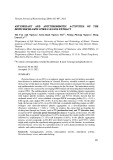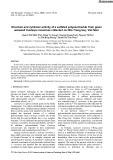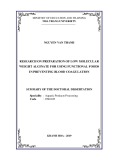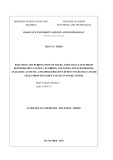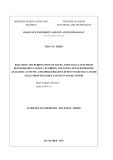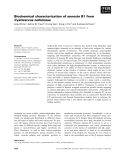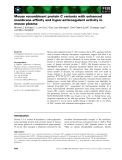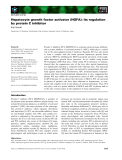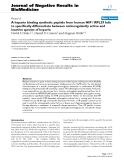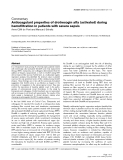
Anticoagulant activity
-
Distichochlamys citrea (DC) is an endemic ginger species used in treating associatedheart diseases in traditional medicine in Vietnam. However, scientific evidence to support the local use of this plant was limited. The present study aimed to investigate the antioxidant and antithrombotic activities of D. citrea extracts for the first time. The antioxidant activity of DC extracts was assessed by scavenging DPPH radical and measuring their total phenolic content (TPC). The antithrombotic activity was evaluated by inhibiting platelet aggregation and prolonging blood coagulation.
 17p
17p  xuanphongdacy06
xuanphongdacy06
 18-09-2024
18-09-2024
 3
3
 1
1
 Download
Download
-
In this work, a new sulfated polysaccharide was isolated from green seaweed Caulerpa racemosa harvested at Nha Trang sea. The structure of obtained polysaccharide was determined and its cytotoxic activity was evaluated. The results showed that structure of the polysaccharide has a main chain of (1→4)-β-D-galactopyranose residues and branches are (1→3)-α-L-glucopyranose-2,4-disulfate residues linked to the main chain at C-6 position.
 6p
6p  dianmotminh02
dianmotminh02
 03-05-2024
03-05-2024
 11
11
 2
2
 Download
Download
-
The purposes of the dissertation: Preparation of low molecular weight sodium alginate from brown algae in Nha Trang Bay which has anticoagulant activity as a raw material for functional food production.
 36p
36p  tunelove
tunelove
 11-06-2021
11-06-2021
 23
23
 3
3
 Download
Download
-
The objectives of the thesis: Research in the toxin/protein having bioactive isolated from Heterometrus laoticus (H. laoticus) scorpion and krait Bungarus fasciatus (B. fasciatus) snake venom.
 32p
32p  extraenglish
extraenglish
 24-05-2021
24-05-2021
 13
13
 3
3
 Download
Download
-
The objectives of the thesis: Research in the toxin/protein having bioactive isolated from Heterometrus laoticus (H. laoticus) scorpion and krait Bungarus fasciatus (B. fasciatus) snake venom.
 32p
32p  extraenglish
extraenglish
 24-05-2021
24-05-2021
 21
21
 3
3
 Download
Download
-
Annexin B1 fromCysticercus cellulosaehas recently been identified using immunological screening in an attempt to find novel antigens for vaccine development against cysticercosis. The protein possesses anticoagulant activity and carries significant therapeutic potential due to its thrombus-targeting and thrombolytic properties.
 10p
10p  inspiron33
inspiron33
 25-03-2013
25-03-2013
 34
34
 5
5
 Download
Download
-
Mouse anticoagulant protein C (461 residues) shares 69% sequence identity with its human ortholog. Interspecies experiments suggest that there is an incompatibility between mouse and human protein C, such that human protein C does not function efficiently in mouse plasma, nor does mouse protein C function efficiently in human plasma.
 17p
17p  viettel02
viettel02
 20-02-2013
20-02-2013
 32
32
 2
2
 Download
Download
-
Protein C inhibitor (PCI; SERPINA5) is a plasma serine protease inhibitor, and a potent inhibitor of activated protein C (APC), which plays a critical role in the anticoagulant protein C pathway. Recently, PCI was also found to form a complex with the serine protease hepatocyte growth factor activator (HGFA), inhibiting the HGFA-catalyzed activation of the single-chain hepatocyte growth factor precursor.
 7p
7p  mobifone23
mobifone23
 21-01-2013
21-01-2013
 44
44
 3
3
 Download
Download
-
Tuyển tập báo cáo các nghiên cứu khoa học quốc tế ngành y học dành cho các bạn tham khảo đề tài: A heparin binding synthetic peptide from human HIP / RPL29 fails to specifically differentiate between anticoagulantly active and inactive species of heparin
 10p
10p  panasonic01
panasonic01
 13-12-2011
13-12-2011
 41
41
 3
3
 Download
Download
-
Tuyển tập các báo cáo nghiên cứu về y học được đăng trên tạp chí y học Critical Care giúp cho các bạn có thêm kiến thức về ngành y học đề tài: Anticoagulant properties of drotrecogin alfa (activated) during hemofiltration in patients with severe sepsis...
 2p
2p  coxanh_3
coxanh_3
 27-10-2011
27-10-2011
 52
52
 4
4
 Download
Download
-
Vaccine Patients recovering from tetanus should be actively immunized (see below) because immunity is not induced by the small amount of toxin required to produce disease. Additional Measures Like all patients receiving ventilatory support, patients with tetanus require attention to hydration; nutrition; physiotherapy; prophylactic anticoagulation; bowel, bladder, and renal function; decubitus ulcer prevention; and treatment of intercurrent infection.
 8p
8p  colgate_colgate
colgate_colgate
 21-12-2010
21-12-2010
 52
52
 2
2
 Download
Download
-
Disseminated Intravascular Coagulation DIC is a clinicopathologic syndrome characterized by widespread intravascular fibrin formation in response to excessive blood protease activity that overcomes the natural anticoagulant mechanisms. DIC is associated with several underlying pathologies (Table 110-2). The most common causes are bacterial sepsis, malignant disorders such as solid tumors or acute promyelocytic leukemia (APL), and obstetric causes. DIC is diagnosed in almost half of pregnant women with abruptio placentae or with amniotic fluid embolism.
 6p
6p  thanhongan
thanhongan
 07-12-2010
07-12-2010
 69
69
 3
3
 Download
Download
-
The central mechanism of DIC is the uncontrolled generation of thrombin by exposure of the blood to pathologic levels of tissue factor (Fig. 110-3). Simultaneous suppression of physiologic anticoagulant mechanisms and abnormal fibrinolysis further accelerate the process. Together these abnormalities contribute to systemic fibrin deposition in small and mid-sized vessels. The duration and intensity of the fibrin deposition can compromise the blood supply of many organs, especially the lung, kidney, liver, and brain, with consequent organ failure.
 5p
5p  thanhongan
thanhongan
 07-12-2010
07-12-2010
 67
67
 3
3
 Download
Download
CHỦ ĐỀ BẠN MUỐN TÌM








